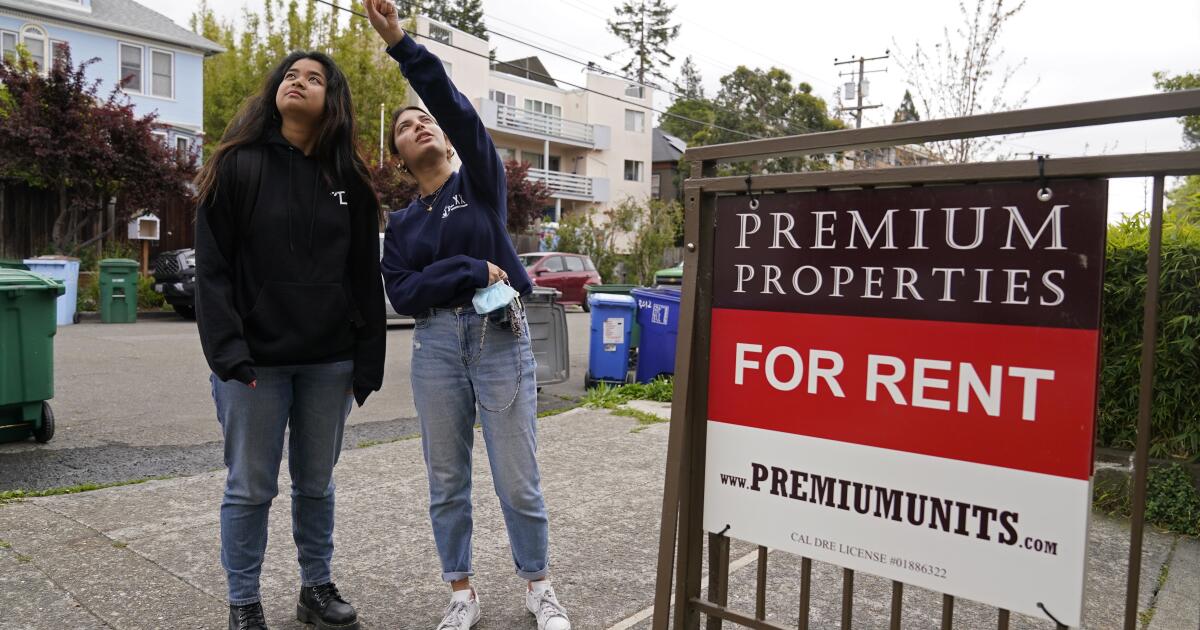Business
Inflation improves slightly in April, but high cost of housing remains a big obstacle

Government data released Wednesday show that inflation eased a bit in April, but remains at a relatively high level. The latest report isn’t likely to lift the grim mood that much of the public has toward an otherwise solid economy.
Though incomes have generally risen more than consumer prices, the overall rate of inflation remains stubbornly high. It dropped a notch in April but was up 3.4% from a year ago, the Bureau of Labor Statistics said.
And unexpectedly, the biggest culprit is housing.
The Federal Reserve’s textbook-perfect policy of fighting inflation by pushing up interest rates has worked in large parts of the economy. The higher interest rates have helped slow growth in consumer prices for items such as food, gas, clothes and cars. Today, the inflation rate for those products is back down to, or even below, the central bank’s 2% target.
But the Fed’s same policy has paralyzed housing, an important segment of the economy, and sabotaged efforts to bring down overall inflation faster.
What the higher interest rates have done is freeze both homeowners and renters in place, discouraging either group from moving. The effect has been strong in California, where housing — what economists call the cost of “shelter” — was already very expensive.
And, in a complicated chain of cause and effect, the fact that both homeowners and renters are staying put has worked to keep inflation high.
“For two years we’ve been waiting for shelter inflation to drop enough to have an effect on the overall inflation rate. It’s constantly disappointing,” said G.U. Krueger, a longtime housing economist in Los Angeles.
“Because of high interest rates,” he said, “there’s no mobility out of rental situations to buy homes. Everyone is stuck — homeowners with golden handcuffs, renters basically with unadorned handcuffs.”
For homeowners, inflation is helping make their homes more valuable. But selling isn’t an option for many because they don’t want to give up their lower mortgage rates. Today the average 30-year fixed rate is more than 7%. Higher home prices also mean they could lose whatever gains they’d made when they replaced the house they’d sold.
For renters, there isn’t even the appearance of gains: They’re frozen in place because rent prices have failed to come down even though many new rental properties have come on the market. The typical rent for apartments and houses combined last month was about $2,920 in Los Angeles, making it one of the least affordable regions in the country, according to Zillow.
With more renters forced to stay put, there’s greater demand for, and lower vacancy at, many rental properties. That’s tended to keep pressure on prices even as more supply has come on line. Builders and landlords also are pricing rents to recoup higher costs for construction and maintenance.
Last month, consumer spending for shelter accounted for about 36% of the basket of goods and services that made up the government’s consumer price index, or CPI.
Fed policymakers track a different inflation measure in which housing isn’t given as much weight in figuring overall inflation. But both tell the same story: Housing inflation is running a lot hotter than for most other consumer goods and services.
In April, consumer prices overall rose 0.3% from March, seasonally adjusted, to an annual inflation rate of 3.4% compared with 3.5% the previous month. While that’s a dramatic decline from a 40-year high of 9.1% in June 2022, the improvement has been slowed by sticky inflation in housing.
Shelter prices in April also nudged down a bit over the month, but they were up 5.5% from a year ago, compared with 2.2% for all other goods and services combined, according to data from the Bureau of Labor Statistics.
Earlier this year, economists were expecting that a bigger decline in overall inflation would prompt the Fed to begin the first of a series of interest rate cuts this spring. But now, with prices for housing and some other services remaining high, many analysts aren’t so sure.
“I just don’t see a catalyst for any kind of rate cut right now,” said Jack Ablin, chief investment officer at Cresset, an asset management and advisory firm. “Maybe if we’re lucky we get one cut this year.”
The Fed’s benchmark interest rate, which influences borrowing rates on homes, cars and credit cards, is at a 23-year high of about 5.3%. Higher interest rates have been felt especially hard in California’s economy, given the importance of interest-sensitive sectors such as high-tech, entertainment and real estate.
One result is that job growth in the state has lagged behind; California’s latest unemployment rate, 5.3% in March, is the highest in the land. The state’s employment report for April comes out Friday.
Experts had been more optimistic about inflation falling faster after seeing signs of declining rents last year. But average rents have begun creeping higher again in recent months, thanks in part to bigger increases for rental houses.
U.S. rents for all housing rose on average 0.6% in April from March, and now stand at a whisker below $2,000 per month, according to Zillow. That’s up 31% since the start of the COVID-19 pandemic.
In high-priced markets such as California, steep home prices and high mortgage rates have made homeownership more elusive and soured people’s mood about the economy, with much of the blame falling on President Biden. Surveys indicate renters are among the least happy in the state and that many are considering moving out of Los Angeles.
Chris Salviati, housing economist at Apartment List, which tracks new leasing activity, said rents have come down significantly from double-digit levels but not fast enough. “It’s still moving in the right direction, but it’s a gradual decline. Certainly it’s been frustrating for folks.”
Why is housing inflation so sticky?
One factor is that most people sign yearlong leases, so there’s a lag and it takes time for changes in rents to show up. When home prices plummeted during the Great Recession, it took about 18 months for the shelter component in the CPI to moderate, said Chris Rupkey, chief economist at Fwdbonds, a financial research firm.
CPI figures on shelter also tend to understate what many consumers are experiencing. The data show that rents for primary residences in Los Angeles and Orange counties rose 4.4% in 2022, even though prices for all other goods and services combined jumped 9.3% that year. Since then, the trend has reversed: inflation for rents and shelter have been growing much faster than for all other items.
Experts say the recent upturn in rents may be due partly to apartment owners trying to recoup their higher costs, as the broader inflationary climate has meant they’re paying more for maintenance, supplies and labor.
“Landlords are trying to catch up,” said Erica Groshen, an economist affiliated with Cornell University and former commissioner of the U.S. Bureau of Labor Statistics, which publishes the CPI reports.
Some experts say that one possible answer to housing inflation is for the Fed to cut rates. While it may seem counterintuitive for policymakers to take such action when the economy and job market are still strong, lowering interest rates could spur mobility and also make it easier for builders to start more projects and thus boost supply.
But boosting demand for home purchases could also add more juice to home prices, at least in the short term, increasing risks of creating housing bubbles.
“For the Fed,” said Rupkey, “it’s damned if you do, and damned if you don’t.”

Business
Food 4 Less workers in California vote to authorize strike

Nearly 6,000 workers at Food 4 Less locations across California this week voted to authorize a strike if Kroger, the grocery chain’s owner, continues with what they say are labor violations during ongoing contract talks.
The vote comes after the union, United Food and Commercial Workers, filed multiple claims of unfair labor practices with the National Labor Relations Board in late May. The union has accused Food 4 Less managers of undermining negotiations, surveilling and discriminating against union members, and trying to prevent employees from participating in union activity.
After a five-day voting period ended Friday, union officials announced workers had “overwhelmingly” voted to approve a potential strike. They declined to disclose how many workers had voted in favor and against the authorization.
“Food 4 Less executives have decided to resort to unlawful tactics instead of following federal labor law and treating the bargaining process with the respect and seriousness that it deserves,” the union said in a statement after the vote. “Food 4 Less is trying to intimidate, bully, and strong-arm us into accepting a contract that is less than what we deserve and far less than what their parent company, Kroger, offers to other union grocery workers in the area.”
A spokesperson for Food 4 Less criticized the union’s decision to seek the strike authorization, saying, “It remains our goal to put more money in our associates’ pockets.”
“We’ve remained committed to negotiating in good faith. From the start, our focus has been on reaching an agreement that benefits our hardworking and dedicated associates,” said Salvador Ramirez, corporate affairs manager at Food 4 Less/Foods Co. “We are deeply disappointed that UFCW Southern California chose to leave the bargaining table before contract expiration, rather than working together to prioritize the needs of their members.”
The mandate gives the union’s bargaining committee more leverage at the negotiating table as Food 4 Less officials know the union could call for employees to walk off the job at any time.
Negotiations over a new contract began nearly three months ago and soon became tense, said Kathy Finn, president of UFCW Local 770, which represents grocery workers in Ventura, Santa Barbara and San Luis Obispo counties and is one of seven union locals involved in the negotiations.
The union locals last negotiated a contract with Food 4 Less in 2021; that contract expired on June 8.
The union has no plans to strike imminently and is preparing for negotiations to resume Monday, Finn said.
Food 4 Less workers are pushing for pay parity with their counterparts at Ralphs. Kroger owns about 300 Ralphs and Food 4 Less stores in the state.
Clerks at Food 4 Less who check groceries and stock shelves make about $4 less in hourly wages than those with the same jobs at Ralphs. That’s in part because the company classifies its Ralphs locations as supermarkets while treating Food 4 Less stores as warehouse stores.
But workers and union leaders, who say there is little meaningful difference between the two chains, also allege a racial element to the pay inequalities. Food 4 Less stores tend to be in lower-income Black and brown communities, while Ralphs generally are located in whiter and wealthier areas, the union says. When asked about the allegation, Food 4 Less representatives declined to comment.
The company’s latest proposal offers an hourly rate increase of about a $1 each year over the course of the contract, amounting to a total boost of $3.25. The union is pushing for about double that increase.
In a statement about the company’s proposal, which was sent to workers Monday, Bryan Kaltenbach, president of Food 4 Less, said, “Hardworking and dedicated associates are the heartbeat of our company, and our goal is to continue to provide market-competitive wages and benefits that we know are so important to our associates and their families.”
Friday afternoon outside a Food 4 Less in Westlake, workers gathered around a table set up to cast their votes.
Jeanne Coleman, a cashier at the Westlake store, voted to approve a strike. She said that besides pay parity with Ralphs, she’s concerned about understaffing. At night, there might be just two cashiers on duty to field the rush of customers that come in to shop after work. Customers waiting in line will begin making calls asking the store to open up another station, she said.
“It’s ridiculous, the issues we have to deal with, but they don’t want to pay us,” Coleman said.
When the union announced it would hold a strike authorization vote, the company began posting notices to hire temporary workers at rates higher than many workers are currently paid, said Tyrone Severe, a cashier at the Westlake store.
“They are trying to hire nonunion workers and pay them more, instead of just negotiating with us,” Severe said. “We think that sucks.”
Members of the union’s bargaining committee accused the company of bargaining in bad faith. For example, during bargaining sessions scheduled for three consecutive days last week, the company’s negotiators showed up late and would leave the negotiation table for hours at a time, workers said.
Visits by Kaltenbach to various stores in recent weeks struck workers as an intimidation tactic.
Christopher Watkins, 24, a meat cutter at a Food 4 Less store in Inglewood, said he’s previously seen the president visit his store about twice a year, but in recent weeks he’s seen him about four times.
Food 4 Less did not provide comment in response to specific questions about worker claims of intimidation and treatment at the bargaining table.
Business
Now bankrupt, MedMen owes millions to other companies. Meet the cannabis CEO who called them out

For a long time, Olivia Alexander defended MedMen.
Despite the pushback she got for partnering with the cannabis chain that some worried would box out smaller brands, Alexander — who founded Kush Queen, which sells cannabis-infused bath bombs and personal lubricant — valued the retailer’s dedication to stocking shelves with products from small, women-owned lines.
“Even though they’re a big company, they support small brands,” she recalled telling people. “They’re good for our industry.”
Now she thinks the opposite.
In March, the retailer that had been valued at more than $1.5 billion when it went public on the Canadian stock exchange six years ago was deep into a cataclysmic downfall. A few weeks later, the company filed for bankruptcy protection in Canada, disclosing it had more than $400 million in liabilities. In Los Angeles County, meanwhile, a Superior Court judge has appointed an attorney to oversee the liquidation of the company’s California subsidiary.
MedMen owes money to not only big legal, accounting and real estate firms, but also vendors such as Alexander who supplied the retailer with products that filled its shelves.
Fed up with what she said had become an open secret in the industry, Alexander fired off a LinkedIn post at the end of last year accusing MedMen of failing to pay a $1,560 invoice for merchandise she’d delivered to them. More than a 100 people commented, including several other entrepreneurs, who said the retail chain owed them money too — often thousands of dollars.
MedMen’s fall has highlighted larger systemic struggles producers such as Alexander face as they try to operate in California’s legal cannabis marketplace. The Times spoke with Alexander about MedMen and the cannabis industry at large. The interview has been edited for brevity and clarity.
Tell me a bit about your company. And how did you start working with MedMen?
I started Kush Queen in 2015. We make a little bit of everything, and we have been working with MedMen almost since the beginning. I really believed, along the way, that we were all part of what I wanted the industry to be, which is diverse and equitable and vibrant.
When did things start to go sour?
I moved to a new distribution company and they were like, “We can’t sell to MedMen. Everyone says they’re going under any minute now.” This was the summer of 2023. But I really thought what everyone else thought, which was that they were too big to fail. So I fought with my distribution partner to deliver these orders and then, of course, they stopped paying.
I went on LinkedIn and wrote the post. And I was inundated — and this is the part that breaks my heart — with messages from tons of brands saying, “Oh yeah, they owe me money.” My LinkedIn DMs are a graveyard of people owed money by MedMen.
MedMen was so afraid of me and the pettiness and my vitriol that they overnighted us a check. They did close out their measly $1,500 invoice with us and I truly believe I was the last person to get paid by them.
How long after your post did they send you a check?
Within two weeks. I posted a follow-up that said, “Look, I’ve been paid, but all these people haven’t.”
What can unpaid invoices mean, especially for smaller companies?
It means they go under or they have to lay people off. If people think it’s bad now, it’s just going to get worse. Everyone is surviving on debt. MedMen was paying a ton of freelance writers to turn out blogs and articles. These are the people that are the most tragic collateral damage of what’s happening.
Can you speak more broadly about the challenges of running a legal cannabis company in California right now?
Like, “How do I do it without crying?” Yeah, it’s tragic. It’s impossible for anyone to make enough money on legal cannabis right now. If I was operating only in the California market, I wouldn’t have enough money to pay my own bills. It’s a loser’s game. The taxes are insane, which is then causing everyone to go to the underground market. The state of California has failed us.
How would you sum up the current state of the industry in one word?
Apocalyptic.
Last month, the Department of Justice formally moved to reclassify marijuana into a category of less regulated substances, a step many in the industry hope could eventually make it easier for cannabis retailers.
Will rescheduling positively affect our industry? Maybe, we don’t know yet. But cannabis and California — there are no two things that go together better. This is our thing and we should be leaps and bounds ahead of every other market. But it’s just been decimated.
Business
Heading to a Disney theme park? More attendees are going into debt for the trip, survey says

With inflation and rising theme park costs, more Disney park visitors are going into debt to pay for their trips, according to a recent survey.
Twenty-four percent of Disney theme park attendees have taken on debt for a trip, up from 18% in 2022, concluded a survey by financial firm Lending Tree, which queried about 2,000 people last month. That number goes up to 45% for parents with children under 18.
On average, parents with young children took on $1,983 in Disney-related debt, the survey found. Concessions were the biggest source of higher-than-expected spending, followed by general transportation costs and accommodations.
But many of those parents were willing to borrow money to finance their Disney trips — 59% of those who went into debt for their trips said they had “no regrets.”
“For so many parents, taking their kids to Disney is a rite of passage, something they remember fondly from their youth and want to experience with their kids,” LendingTree chief credit analyst Matt Schulz said in a statement. “Because of those feelings, they’re often willing to take on debt to get there.”
The survey did not specify which parks respondents visited, whether in the U.S. or international. Lending Tree’s definition of “debt” includes credit card debt, personal loans, borrowing against one’s home and debt that incurs interest.
A Disney representative was not immediately available for comment.
Disneyland Resort in Anaheim began using a demand pricing system in 2016 that reduces the prices on low-demand days and increases them on high-demand days. The price for a one-day, one-park ticket can range from $104 to $194, though the minimum price can decrease to $83 a day as part of a multi-day, weekday ticket package.
Disney fans have groused about ticket price increases, including more paid add-ons that were previously free.
Last year, Walt Disney Co. Chief Executive Bob Iger admitted that the Burbank entertainment giant was “a little bit too aggressive about some of our pricing” in its zeal to increase profits. The company then expanded the number of lower-priced days and restored some of the free add-ons.
The company’s so-called “experiences” division, which is heavily anchored by its theme park empire, brought in about 70% of Disney’s operating income last year. Disney is now embarking on a plan to invest $60 billion over 10 years into that division, including heavy spending in its theme parks.
-

 News1 week ago
News1 week agoWoman handcuffed in police car hit by freight train reaches $8.5M settlement
-

 Movie Reviews1 week ago
Movie Reviews1 week agoStream It Or Skip It: ‘Under Paris’ on Netflix, a shark-in-the-Seine thriller that delivers the ludicrousness you crave
-

 News1 week ago
News1 week agoIsrael used a U.S.-made bomb in a deadly U.N. school strike in Gaza
-

 World1 week ago
World1 week agoEconomy, migration: Voters' main concerns ahead of elections
-

 Politics1 week ago
Politics1 week agoTrump campaign accelerates vetting of potential running mates
-

 Movie Reviews1 week ago
Movie Reviews1 week agoShort Film Review: Blue and White (2022) by Hiroyuki Nishiyama
-

 World1 week ago
World1 week agoWorld leaders, veterans mark D-Day’s 80th anniversary in France
-

 World1 week ago
World1 week agoFrance to provide Ukraine with its Mirage combat aircraft















